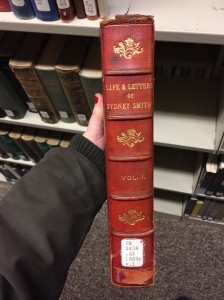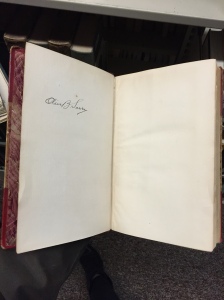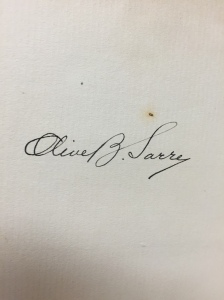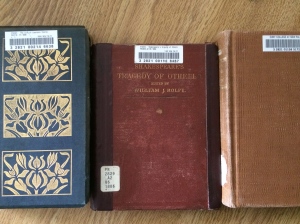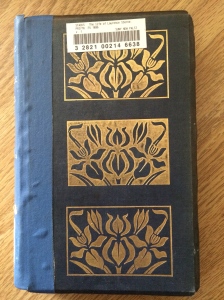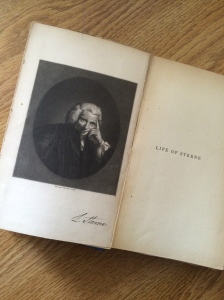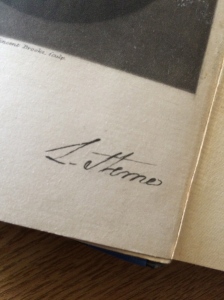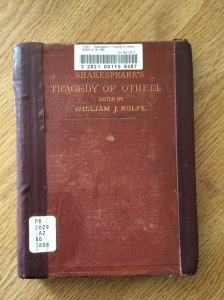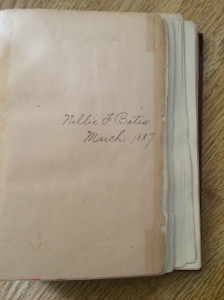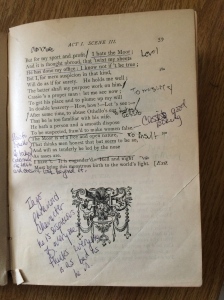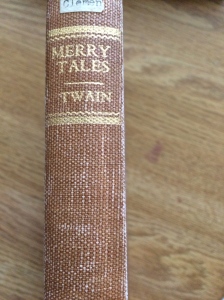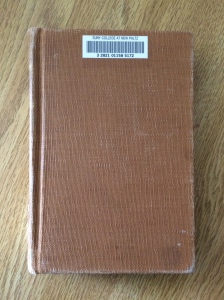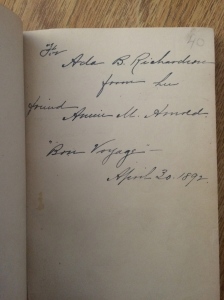#BlogPost
DeFranco_GoogleNgrams Assignment
 For the Ngrams assignment I chose to look at the comparison between newspapers and magazines and I found it interesting that newspapers surpassed magazines around 1815. This could have happened for many reasons but I’ve made a few inferences. The first is that, though newspapers, in their earliest form, were first developed in the 1600s, it was not until the early 1800s that they began to become more standard, available and affordable. This is indicated where the increase in the word newspaper becomes clearly defined around 1825. Before this, both ‘newspaper’ and ‘magazine’ were pretty steady over the years with magazines even beginning on top. My theory for the much slower growth of magazines is that, like today, magazines were bought mostly for soft stories and entertainment. So big news events that effected the sales and popularity of newspapers had little to no effect on magazines.
For the Ngrams assignment I chose to look at the comparison between newspapers and magazines and I found it interesting that newspapers surpassed magazines around 1815. This could have happened for many reasons but I’ve made a few inferences. The first is that, though newspapers, in their earliest form, were first developed in the 1600s, it was not until the early 1800s that they began to become more standard, available and affordable. This is indicated where the increase in the word newspaper becomes clearly defined around 1825. Before this, both ‘newspaper’ and ‘magazine’ were pretty steady over the years with magazines even beginning on top. My theory for the much slower growth of magazines is that, like today, magazines were bought mostly for soft stories and entertainment. So big news events that effected the sales and popularity of newspapers had little to no effect on magazines.
The sharp rise of newspapers in the early 1830s was most likely brought about by the following societal developments: First, in 1831 The famous abolitionist newspaper The Liberator is first published by William Lloyd Garrison. Second, there was the The New York Sun newspaper that in 1833 cost one cent–this was the beginning of the penny press. Another spike shown on the chart for newspapers is around 1880. In this year the first halftone photograph (Shantytown) was published in a newspaper, most likely increasing their popularity. At the same time advertising was becoming more and more relevant with the first whole page newspaper ad placed by an American department store (John Wanamaker) was run in 1879. I imagine this would also increase the mentions of the word newspaper over time.
As for magazines there didn’t seem to be any spikes until about 1855. When I researched possible reasoning for this I found that in 1855 Illustrated London News published a Christmas special with a color cover produced using colored wood blocks. This magazine sold 130,000 copies a week–10 times the daily sale of The Times. That may have had something to do with that blip. When magazines start to grow steadily at the end of the 19th century this is most likely because, like newspapers, magazines began to increase in availability and affordability–leading to popularity.
Sources:
http://inventors.about.com/od/pstartinventions/a/printing_4.htm
http://www.magforum.com/time.htm
Communication Through Time: Telegraph vs. Telephone
Something that particularly interests me is modes of communication throughout the ages. From the 19th century through today, we experienced huge advances in technology that helped to sculpt the way we live in this day and age. Two of the biggest forms of communication that arose during the Victorian era were the telegraph and the telephone, which I decided to compare for this assignment.
 I was surprised at my Ngram chart results because I was expecting there to be a much bigger rise in the telephone from the time it was invented in 1876. Though it did receive wide popularity before 1900, I thought it was interesting to see that the telegraph still exceeded it by a significant amount by the end of the century.
I was surprised at my Ngram chart results because I was expecting there to be a much bigger rise in the telephone from the time it was invented in 1876. Though it did receive wide popularity before 1900, I thought it was interesting to see that the telegraph still exceeded it by a significant amount by the end of the century.
The telegraph’s mentions begin before 1800, when the electric telegraph was first being developed. But its growth begins in 1830, when Samuel Morse perfected this invention for long distance communication with the help of his system called Morse Code. The telegraph became quickly accepted by the public as a faster way of sending and receiving information. Its rise continued consistently as it came into use all around the world until around 1860, when the first transcontinental telegraph line was cerated. This sparked a jump in the chart as telegraph’s came into use worldwide. Something I also noticed was after the telephone was invented, you still see the telegraph going up, but it’s not as consistent anymore and you see more drops in the graph.
In 1876, when the telephone was invented, it automatically made a significant jump in the amount of times it was mentioned in texts, as you see a slight fall in the telegraph. The telephone came into wide use very quickly, with around 10,000 telephones in service by 1878. In the 1880’s, the telephone continues its upward climb with the development of long distance service from the Bell Telephone Company, which was the only telephone company at the time. In the 1890’s, independent phone companies began to pop up all around, giving the Bell Company competition and also supporting the continuous rise of the telephone.
I also wanted to see when exactly the telephone became more popular than the telegraph. In 1900, the telephone’s book mentions skyrocket and exceed that of the telegraph by 1905, a huge jump in just 5 short years. Since then, the telephone has almost continuously risen until modern years while the telegraph has continuously fallen to almost 0% on the Ngram chart.
Overall, I thought it was interesting to see how the amount of mentions in books and texts correlate to popularity. I was surprised to see that mentions of the telephone didn’t rise over that of the telegraph until 1905 because its usage grew so quickly in such a short amount of time. But since the telegraph was so common and prevalent in that society, it took awhile for it to lose that popularity, something that still happens all the time with technology today.
A new view of great Victorian writers
Charles Dickens, Edgar Allan Poe and Herman Melville are three Victorian authors that particularly interest me. The choice of settings to search for them on Ngram Viewer was simple, then. My single concern was using capital letters, as I was searching for people’s names and limit the period of time from 1800 to 1900.
According to the resulting graphic, the three writers are not mentioned until 1833, as they were really young and starting their careers. Poe was born in 1809, Dickens was born in 1812 and Melville in 1819. Dickens started submitting his sketches of the life in London to magazines in 1833. It is exactly the year that the graphic shows that he started to be more mentioned, a movement that continued increasing till 1871. A suggestion for the relative decrease in the graph at this time in his death on June 8, 1870. He left an unfinished novel, The Mystery of Edwin Drood. It has already started to be published in a serial form since April 1870. Analyzing the graphic, we can consider that Charles Dickens died on the top of his career. Since 1877, we can verify a new growth in his “popularity”. In this year, a book called The works of Charles Dickens was published and may be the reason to this new growth.
In the case of Herman Melville, we can see that he has been more mentioned during the 1840s. It may be related to his trips over the sea, that gave him the material for four books in addition to Moby Dick. However, this novel that would be his great success, was not received well at the time because of its unusual combination of “whaling lore” and metaphysical themes. This may be the reason of his relatively low popularity over the 19th century, compared to Charles Dickens.
Edgar Allan Poe had a brief life – he died on October 7, 1849, before he has started to be more mentioned, according to Ngram Viewer. The graphic shows a special increase in Poe’s mentions over the 1870s. The reason may be the biographies and other works about him that have been published since 1870.
Word Cloud: A Case of Identity
For this project, I decided to make some word clouds based off of the Sherlock Holmes story A Case of Identity. I thought that this project was a fun experience, and it’s definitely something that I’ll try using again. After listening to our guest speaker last class talk about graphic design and how to make our digital projects look more visually pleasing, I was excited to jump into this project. I first decided to make a word cloud using Voyant (as shown below).
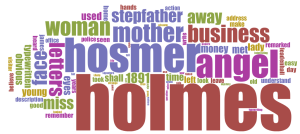 I was hoping that when I submitted my story, it would automatically turn out like this, but I had to make a few tweaks with the stop words before I got to this final result that I think turned out pretty well. I think that it emphasizes many of the core themes and major words that you need to know in order to get at least some idea of what the story is about. I don’t think this type of chart in general is the most easy to understand, but it’s visually appealing with the fun colors and the simple font. I also really liked how user-friendly the site was, and it wasn’t hard to make edits to it.
I was hoping that when I submitted my story, it would automatically turn out like this, but I had to make a few tweaks with the stop words before I got to this final result that I think turned out pretty well. I think that it emphasizes many of the core themes and major words that you need to know in order to get at least some idea of what the story is about. I don’t think this type of chart in general is the most easy to understand, but it’s visually appealing with the fun colors and the simple font. I also really liked how user-friendly the site was, and it wasn’t hard to make edits to it.
Unfortunately, my ancient computer couldn’t handle any Java or Silverlight updates, so I wasn’t able to use Wordle or Tagxedo. I’m still kinda bummed because I looked at the word clouds that other people posted and they look really cool. But I was informed of another word cloud website called JasonDavies.com (as shown below)
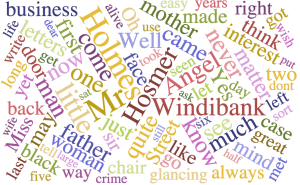 This word cloud is a lot more cluttered than the one from Voyant and I didn’t really enjoy using it. It only lets you change the font, which is a bit restricting when trying to make something look more visually appealing. And after using Voyant, it was a bit disappointing not being able to change anything other than the font. Most of the words are around the same size, so you can’t really tell which words are the most important. If someone who had never read the story before looked at this word cloud, I don’t think they would have a clue what the story was about.
This word cloud is a lot more cluttered than the one from Voyant and I didn’t really enjoy using it. It only lets you change the font, which is a bit restricting when trying to make something look more visually appealing. And after using Voyant, it was a bit disappointing not being able to change anything other than the font. Most of the words are around the same size, so you can’t really tell which words are the most important. If someone who had never read the story before looked at this word cloud, I don’t think they would have a clue what the story was about.
A Memoir of the Reverend Sydney Smith: 19th Century Book Study
While looking through the stacks of the Sojourner Truth Library, I found some marginalia traces as well as a few newspaper inserts in one of the first 5 books that I looked in (a very lucky find). The book is titled A Memoir of the Reverend Sydney Smith. This book was written by Reverend Sydney Smith’s daughter, Lady Saba Holland, in 1855, 10 years after Sydney Smith’s death, and was published in London. Reverend Sydney Smith was a 19th century English clergyman and writer.
This book is the first of two volumes, with this volume having the title the Life & Letters of Sydney Smith.
The marginalia trace that I found is right before the title page of the book, on the inside cover page. So when I first opened the book, I immediately hit jackpot. It’s written in fountain pen, which was the biggest indication that this is a trace from the 19th century. This is probably the signature of the original owner of this book. From inspection, it looks like it says the name “Olive B. Sarry”. It bummed me out because I spent some time trying to research the name, but I couldn’t find any clues to help me figure out who this person was.
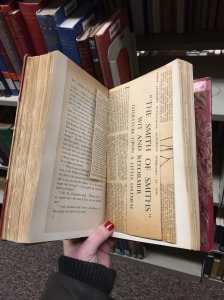
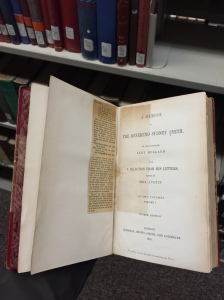
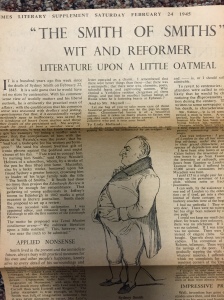
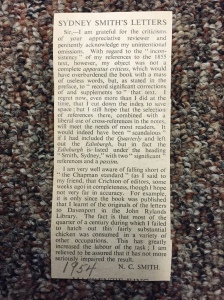
The other things that I found in this book were newspaper inserts that all pertained to Reverend Sydney Smith. They range from about 1945-1954. Though they’re not from the 19th century, I still thought that they were a really cool find. The first one that I found is pasted right on the title page. It’s an article called No Matter, talking about a man named Bishop Berkeley and his criticisms against Sydney Smith. I also found a couple newspaper inserts on page 448. One of them is from the Times Literary Supplement, a weekly literary review published in London.
Along with this, there were a few other little notes that I found written throughout the book. They seemed to be random numbers (or years?) written in pencil, so they might not be from the 19th century.
*Also, here’s my link to my submission to Book Traces!
Project_19th Century Books with Marginalia_DeFranco
I got carried away in the library looking for books that would meet the criteria for this project. I must have spent at lease two hours total searching high and low. I want to share some of my smaller discoveries in addition to the one that I think is the most substantial.
The first marking of interest came from a book called The Life of Laurence Sterne by Percy Fitzgerald. (1896, Downey & Co. 21 York St., Covent Garden, London) This book has a script (probably male?) name, “Letteme” in the first few pages under a black and white photograph of a man. It looks authentic (pen type and writing style, dark/light, etc.) but I’m not positive that it’s written and not copied or printed.
The second book I looked at was Shakespeare’s Tragedy of Othello, The Moor Of Venice, edited, with notes, by William J. Rolfe. (1886, New York” Harper & Brothers, Publishers, Franklin Square.) This book has a name and date “Nellie F. Bates March 1887” in the light, more frilly andornate feminine looking penmanship. This book also included many markings within the body text pages but it seems to be much more modern and probably done by students using the books for projects etc. I’m including a picture of these markings anyway because I still think they’re interesting.
It is my inference that both of these old signatures are just the names of the people who owned the books wanting to mark them as their property.
The third and most interesting marginalia I found went beyond just a name within the first few pages. This book, by Mark Twain, entitled Happy Tales (1892, New York: Charles L. Webster & Co.) has a note indicating that the book was a gift from one person to another as they were leaving. The note reads, (though I’m not sure I’m transcribing the names 100 percent accurately) “For Ada B. Richardiore from her friend Annie M. Amred. ‘Bon Voyage’ — April 30. 1892.” What I’m putting together is that this was a woman giving this book of short stories to her leaving friend, that they may not see each other for a long time or even ever again, and finally that she wants her friend to have “Happy Tales” of her own.
*Here is the link to my entry on Book Traces!
Adrian Jurek Extra Credit: Victorian London – Police and Policing
Searching through the different terms on the Dictionary of Victorian London i came across a post about “Victorian Era Police”. This really interested me because i never really researched Victorian era law enforcement and the images that keep popping into mind are those from the Sherlock Holmes movie that came out in 2009. This article can be found under: Police; City of London Police; -duties and organization.
Since the City of London was the wealthiest business center of the world, they had their own police force that only watched the city in both day and night. The goal of the policemen was to get a high number of convictions using any means necessary. There was no checks of what the police was doing. The press, unlike today, didn’t accuse officers of corruption , or any malpractice.
One thing that interested me that, in addition to arresting criminals, officers helped out civilians by escorting old ladies to their homes , looking out for future crimes, etc. In addition to this there was a Nightwatch established which patrolled the streets from 10 P.M. to check stores, and prevent any thievery. As quoted from the author, ALEX. INNES SHAND. , “the City police has arrived at pretty nearly the perfection of efficiency” . This is an example that you don’t need to have superior technology to be highly efficient in what you are doing. According to the chart that is found midway through the article there was 800 total officers working in London in the public sector and 99 policeman in the private sector, both a fairly large amount of officers.
My Verrrry First Blog Post
Hello, My name is Kiran Kalantri. I am a Digital Media Production Major at SUNY New Paltz. I have just started my second semester of sophomore year. I am also quite excited to be taking this course. My hobbies include writing, listening to music, playing with my cat, gaming, and trying to comprehend the importance of Kid Ink in the rap community. I’m also excited to start recording an EP with my friend, Josh, “The WZA”.
He enjoys to call himself that. He’s weird.

How to create a successful Digital Humanities Project
My ideas of what creates a well done digital humanities project, it should include:
1. It should be easy to use which makes the project more desirable to that project over others.
2. It needs to be visually appealing with a well-constructed layout so the information is easily seen.
3. The project should be focused on a theme makes it more relevant for readers interested in that topic.
4. The data needs to be cited correctly, data that is from academically or scholarly sources is preferred.
5. The project should be searchable, when there are different collections of data in one area.
Questions:
1. What makes a good DH project?
A good digital humanities project is almost all of the things I stated above but can include much more. For instance, interactive DH projects make it easier for an individual to obtain more from the project with a sort of fun learning experience. Also, along with being cited correctly, a project should have an “about page,” so the people visiting these projects knows what exactly is trying to be shown through the collection of data. That data needs to be clear and focused for it to be a usable and good DH project otherwise the project will be pretty irrelevant to researchers and individuals interested in these themes. You want to make sure your DH project has a well done concept along with these other guidelines unless you want it to be an example of what not to do for a DH project.
2. How does DH let scholars ask new questions?
Digital Humanities is a newer concept that has been growing over the past few years. It is creating newer ideas and tools to help the fast paced age of technology. It has given the ability to digitize books and give us new tools and resources. This newer way of thinking lets scholars ask new questions in itself to come up with new tools that can help groups become better with literature, knowledge, and technology. For example, it helps scholars ask questions by putting together new ideas on themes that others would maybe have not paired together. Certain Digital Humanities tools lets you combine topics to see the data that comes up behind it such ask the project we did on topic modeling. You can search through many different themes that you maybe did not think they would have anything to do with each other through out novels in history.








